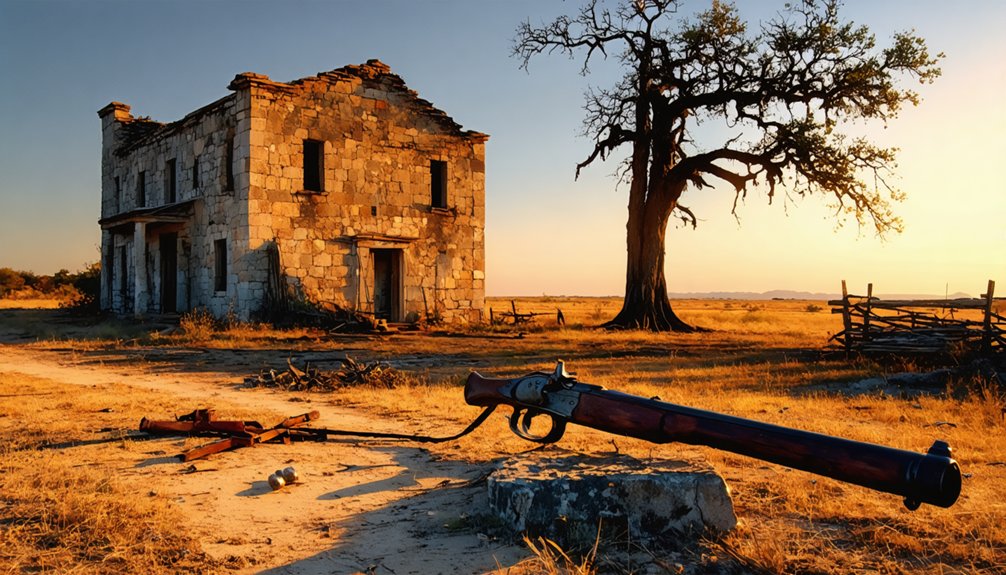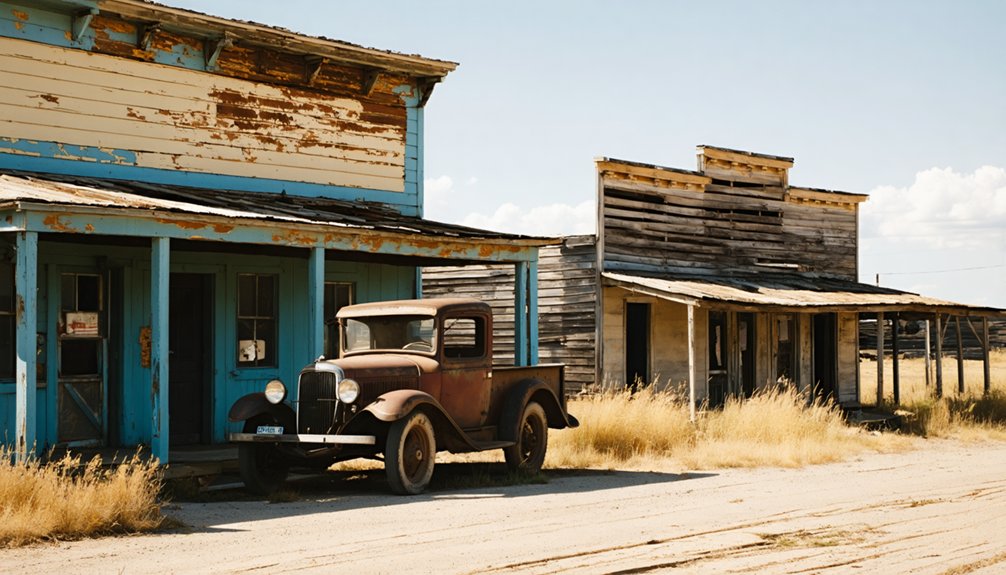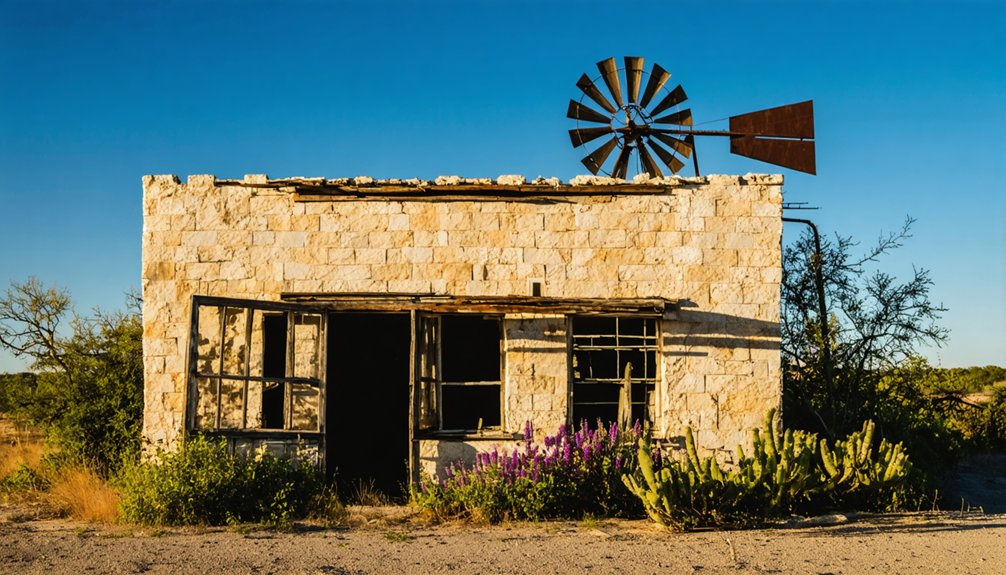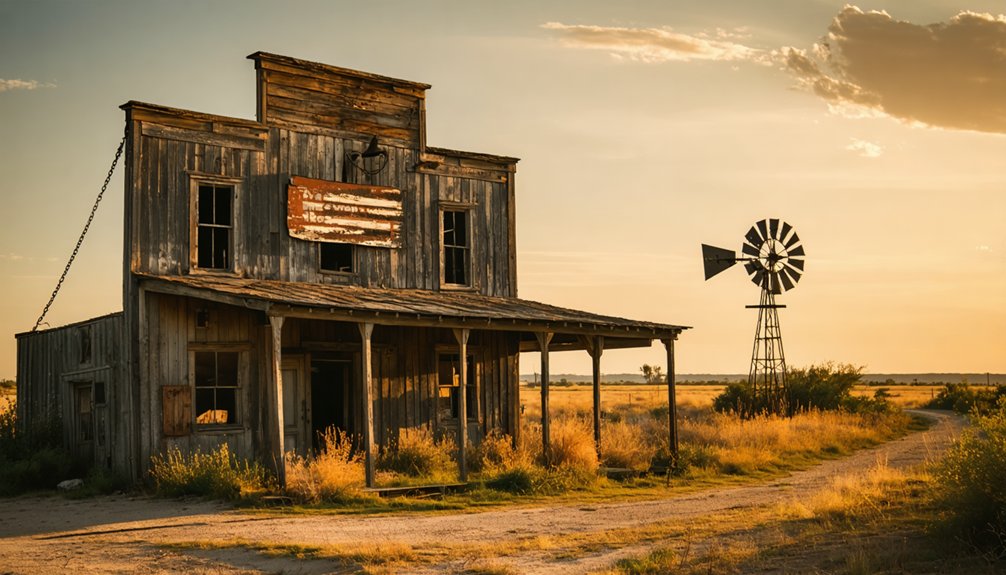You’ll find Calf Creek, a ghost town in McCulloch County, Texas, through its three historic names: Deland, Tucker, and Calf Creek. Founded in 1874 by pioneering families, the settlement thrived with ranching, cotton farming, and a concrete schoolhouse until 1949. The town’s significance stems from James Bowie’s 1831 battle against Native Americans and its role as a farming hub. Today, only crumbling foundations and a historic cemetery with 279 memorials hint at the deeper stories waiting to be discovered.
Key Takeaways
- Calf Creek is an abandoned Texas settlement that cycled through three names: Deland, Tucker, and Calf Creek before becoming a ghost town.
- The town’s remaining structures include deteriorating buildings, crumbling foundations, and a historic cemetery containing 279 memorial records.
- A concrete block schoolhouse built in 1921 served the community until 1949, marking one of the town’s last active institutions.
- The site holds archaeological significance, with artifacts revealing hunter-gatherer activities from approximately 6,000 years ago.
- Historical markers near FM 1311 and FM 503 commemorate the ghost town’s significance, though private ownership restricts access to the site.
The Origins of Three Names
While many ghost towns have a single name throughout their history, Calf Creek in McCulloch County, Texas, evolved through three distinct designations that reflected its changing character.
You’ll find this name evolution began with “Deland,” honoring the pioneering family who settled there in 1874. The settlement later became “Tucker,” recognizing another influential landowning family’s impact on the area.
Finally, it settled on “Calf Creek,” drawing its name from a crucial waterway where ranchers constructed corrals for their cattle operations. Today, visitors can explore the concrete block schoolhouse built in 1921, which stands as a testament to the town’s educational heritage. Each name change marked significant historical shifts in the community’s development.
The progression from family names to a geographical feature mirrors the settlement’s transformation from scattered homesteads to an established ranching hub, showcasing the historical significance of naming practices in frontier Texas communities. The area gained additional historical importance after the 1831 battle with Indians, where Jim Bowie’s group emerged largely victorious.
Life on Calf Creek’s Historic Grounds
You’ll find evidence of Calf Creek’s vibrant past in the 1921 concrete block schoolhouse that served as both an educational center and community gathering place until 1949.
The six-acre property, donated by the Huey family in 1902, included a two-acre cemetery that became a monument to the area’s founding families and their agricultural heritage. The site gained historical significance after James Bowie’s battle against over 150 Native Americans took place there in 1831.
While ranchers populated the region in the 1870s and 1880s, establishing the foundations for a close-knit farming community, the schoolhouse’s eventual demolition between 2004 and 2005 marked the final chapter of Calf Creek’s communal infrastructure. Archaeological evidence suggests that nomadic hunter-gatherers inhabited this area thousands of years before the first European settlers arrived.
Daily Ranch Community Life
As families settled into Calf Creek’s historic grounds in the early 1900s, they established a vibrant community centered around agriculture, faith, and mutual support.
You’d find ranching practices that combined cattle grazing with cotton farming, supported by two local cotton gins and essential blacksmith services. Daily life revolved around self-sufficient homesteads, positioned near water sources and historic ranch bluffs. Recent archaeological studies by Rice University researchers have uncovered artifacts showing the area’s rich history of human settlement. The land holds special historical significance with its Native American mounds and burial sites that have been preserved through generations.
Community gatherings were the heartbeat of social life, especially during annual camp meetings held at the Deland place each August. You’d witness Methodist and Baptist congregations sharing union literature and worship services until 1940.
The Tucker community center, complete with a general store and post office, served as a hub until fire destroyed it in 1915. By 1914, telephones connected residents at 75 cents monthly, with a switchboard operated from a local home.
Early Settlers’ Family Stories
Since James Bowie’s 1831 battle against indigenous tribes, the land that would become Calf Creek has carried deep historical significance for its settler families.
Archaeological evidence shows the area’s earliest inhabitants were skilled hunters who relied heavily on large game animals.
Early settler anecdotes reveal the challenges of carving out a life in this remote territory, where families had to band together for survival and mutual support. You’ll find their family lineage woven through the town’s multiple relocations – from Deland to Tucker, and finally to Calf Creek. The community maintained mail service from 1906 until its discontinuation in 1953.
Through letters and oral histories, descendants preserve tales of their ancestors’ determination to transform harsh ranchland into a viable community.
Despite isolation and limited resources, these pioneering families established deep roots, as evidenced by the cemetery records, concrete schoolhouse remains, and original homestead foundations that still dot the landscape today.
Cemetery and School Legacy
Two enduring landmarks chronicle Calf Creek’s pioneering spirit: the historic cemetery on FM 1311 and the former school grounds that once bustled with community life.
The cemetery symbolism runs deep, with 279 memorial records telling the story of diverse settler families across its 2+ acres. You’ll find this sacred ground was part of the Huey family’s generous 6-acre donation in 1902, which also accommodated the schoolhouse.
The school’s evolution mirrors the community’s journey: from a wooden structure in 1903 to a concrete block building in 1921, funded by an $8,000 bond.
This school community thrived until 1949, when it merged with Brady ISD. Though the building served as a church afterward, it succumbed to time and was demolished in 2004-2005, leaving only memories and foundations.
A School’s Rise and Fall
While frontier communities often struggled to establish educational institutions, the Calf Creek school emerged as a vital community cornerstone by 1898. With twenty-three students under a single teacher’s guidance, the school’s history paralleled the town’s growth, especially as Baptist and Methodist churches organized in 1903. The area’s historical significance was marked by the Bowie brothers who fought in a notable battle against Native Americans in 1831.
You’ll find that this one-room schoolhouse served as more than just a place of learning – it was a hub for community gatherings and social activities. A new school building constructed in 1921 could accommodate up to 100 students.
Yet, by the mid-20th century, shifting demographics spelled trouble. As families moved away and the population dwindled to around 50 residents, the school couldn’t sustain itself. In 1949, Calf Creek’s school merged with Brady schools, marking the end of an era and reflecting broader changes that transformed many Texas frontier communities into ghost towns.
Jim Bowie’s Famous Battle

You’ll find the site of Jim Bowie’s legendary battle near Calf Creek, where in 1831 he and ten companions outmaneuvered over 150 Caddo and Lipan warriors from a defensive position in a live oak grove.
Through Bowie’s tactical leadership and careful ammunition conservation, his small band withstood thirteen hours of attacks, including attempts to flush them out with prairie fires.
Though exact Native American casualties weren’t recorded, Bowie’s strategic victory came at the cost of only one man, Tom McCaslin, while successfully repelling the much larger force.
Location of the Fight
The historic Bowie-Indian battle took place near Calf Creek in McCulloch County, Texas, approximately half a mile southwest of the present-day Calf Creek townsite along FM 1311.
You’ll find the battle geography centered around a defensive position that offered Bowie’s men significant tactical advantages. They fortified their camp within a grove of about 40 live oak trees, with a nearby thicket providing additional cover.
The thicket measured roughly 10 feet high, 40 feet long, and 20 feet wide, with a cleared pathway about 10 feet from its outer edge. An essential water source, Calf Creek itself, lay about 40 yards to the west.
Today, you can visit the Centennial Marker situated near the junction of FM 1311 and FM 503, about a mile south of Calf Creek Cemetery, marking this pivotal frontier confrontation.
Bowie’s Strategic Victory
Jim Bowie’s strategic brilliance shone through his masterful handling of the Battle of Calf Creek, where his small party of 11 men faced overwhelming odds against 164 Native American warriors. His tactics maximized their terrain advantage, utilizing a grove of 40 live oak trees for cover and clearing nearby thickets for improved movement.
Despite attempting peaceful negotiations, you’ll find that Bowie’s strategic planning proved essential when talks failed violently. After warriors fired upon his men, Bowie’s group adapted to guerrilla warfare tactics, making expert use of their defensive position near Calf Creek.
Their battle endurance was remarkable – fighting for 13 exhausting hours against a massive numerical disadvantage. While they lost one man, Tom McCaslin, Bowie’s tactical expertise and leadership guaranteed the survival of his remaining forces, cementing the battle’s historical significance.
Native American Battle Casualties
Devastating losses struck Native American forces during the 1831 Battle of Calf Creek, where approximately 40 warriors died and 30 suffered wounds in their confrontation with Bowie’s small band.
The combined Caddo and Lipan force of 150-164 warriors attempted to overwhelm Bowie’s position using Native tactics of encirclement and natural cover, but their strategy proved costly against the defenders’ effective response.
The casualty impact proved significant, with over half their fighting force eliminated or wounded during the 13-hour engagement.
You’ll find this battle marked a turning point in local Native resistance, as the severe losses temporarily weakened their ability to conduct raids in the region.
While some historical accounts may underreport Native casualties, the battle’s outcome clearly demonstrated the steep price paid by the indigenous warriors at Calf Creek.
The Community’s Golden Years

During its peak years in the early 20th century, Calf Creek flourished as a quintessential Texas ranching community, complete with a post office, churches, and a substantial four-room concrete block schoolhouse built in 1921.
You’d have found a tight-knit ranching culture centered around livestock operations and agricultural pursuits, with local families gathering for community events at the schoolhouse.
The town’s infrastructure, while modest, served the needs of its hardy residents who’d carved out a living from the surrounding ranchlands.
Though commercial buildings were few, they provided necessary services to the area’s ranching families.
Limited in number but vital in purpose, the town’s commercial structures served as lifelines for the hardworking ranch families.
The town’s social fabric wove together through its churches, school activities, and shared agricultural lifestyle – a reflection of the independent spirit that defined these frontier settlements in early 20th century Texas.
What Remains Today
As time and Texas weather have taken their toll, Calf Creek stands today as a shadow of its former self, with only a handful of deteriorating structures marking what was once a vibrant ranching community.
You’ll find architectural remnants scattered across the landscape – collapsed wooden buildings, crumbling stone foundations, and weathered fence posts that hint at property boundaries long forgotten.
Without any modern infrastructure or utilities, these physical remnants serve as the last witnesses to Calf Creek’s past. The site’s historical preservation remains minimal, with private ownership limiting access and development.
If you venture down the dirt roads that lead to this ghost town, you’ll discover a quiet expanse of Texas Hill Country where rusted artifacts and broken foundations tell stories of the community that once called this place home.
Legacy in the Texas Hill Country

The legacy of Calf Creek extends far beyond its weathered ruins, weaving through multiple layers of Texas Hill Country history.
You’ll find its cultural heritage preserved in the archaeological discoveries of the Calf Creek Horizon, which spans an impressive 500,000 square miles and reveals sophisticated stone tools from hunter-gatherers who lived there 6,000 years ago.
The site’s significance deepened in 1831 when James Bowie fought a notable battle against Caddo and Lipan Indians near the creek.
By the early 1900s, you’d have seen a thriving community where the Attaways, Kolbs, and other pioneering families built churches, cotton gins, and stores.
Though the town has vanished, its impact on Texas frontier history endures through historical markers and the cooperative spirit of its early religious congregations.
Frequently Asked Questions
What Wildlife Species Can Still Be Found Around Calf Creek Today?
You’ll discover rich species diversity around Calf Creek’s waters, where wildlife conservation efforts protect red-tailed hawks, canyon wrens, channel catfish, Texas horned lizards, and exotic axis deer.
Were There Any Notable Natural Disasters That Contributed to Calf Creek’s Decline?
You won’t find evidence of flood damage or drought impact causing Calf Creek’s decline. Historical records show the town faded due to population shifts and economic changes rather than natural disasters.
What Crops Were Primarily Grown by Early Calf Creek Farmers?
Like seeds scattered in fertile soil, you’d find maize as the cornerstone crop, alongside beans and squash in traditional polyculture gardens. Cotton production came later, with farmers practicing crop rotation for sustainability.
Are There Any Annual Events or Reunions Held at Calf Creek?
You won’t find regular annual celebrations at this location today, though you might encounter occasional community gatherings during the “Back to Rath’s Trail” heritage events that include the ghost town.
What Native American Tribes Originally Inhabited the Calf Creek Area?
Like ancient footprints in time, you’ll find the Lipan Apaches and Tonkawas were the first Native tribes of historical significance here, starting in the 14th century, before Comanches and Kiowas arrived later.
References
- https://en.wikipedia.org/wiki/Calf_Creek
- https://www.ghosttowns.com/states/tx/calfcreek.html
- https://en.wikipedia.org/wiki/List_of_ghost_towns_in_Texas
- https://www.tshaonline.org/handbook/entries/calf-creek-tx
- https://www.texasescapes.com/TexasHillCountryTowns/Calf-Creek-Texas.htm
- https://www.texasescapes.com/TOWNS/Texas-Ghost-Towns-3-Hill-Country.htm
- https://www.tshaonline.org/handbook/entries/calf-creek-menard-county
- https://roadtripswithlisa.tripod.com/ghost_towns.htm
- https://bornoftexas.com/bowies-battle-with-indians-at-calf-creek/
- https://www.youtube.com/watch?v=doH8q20oWh0



